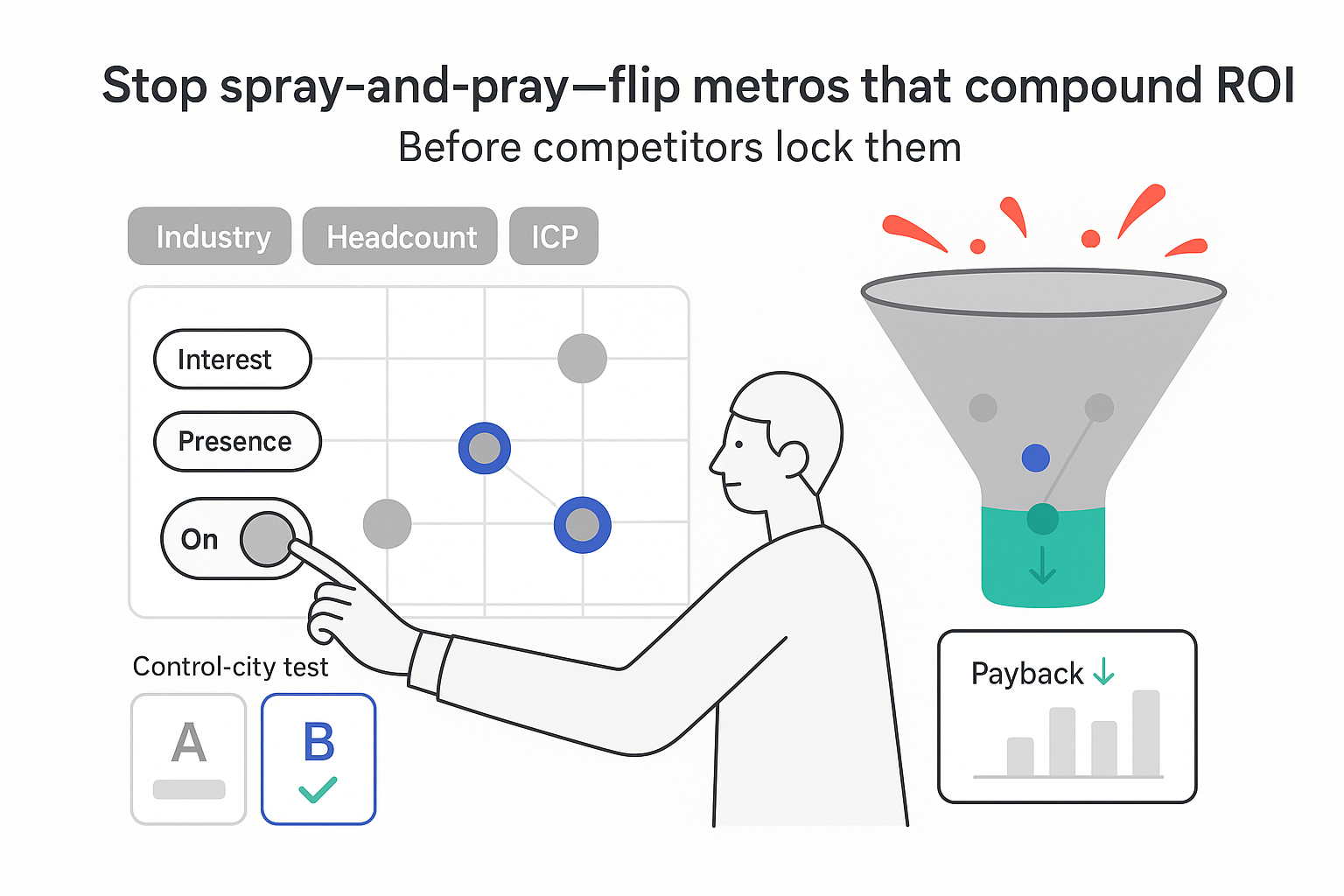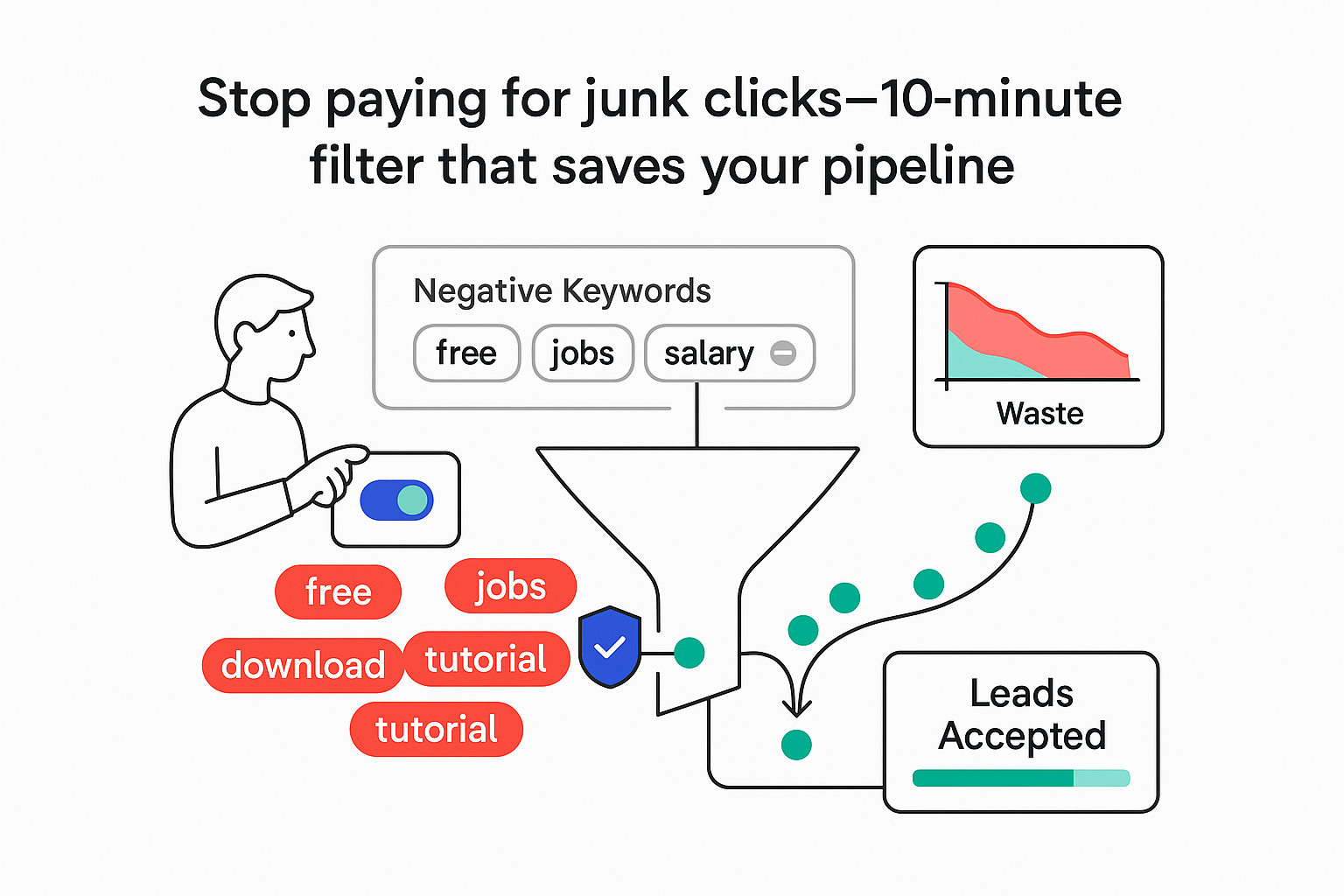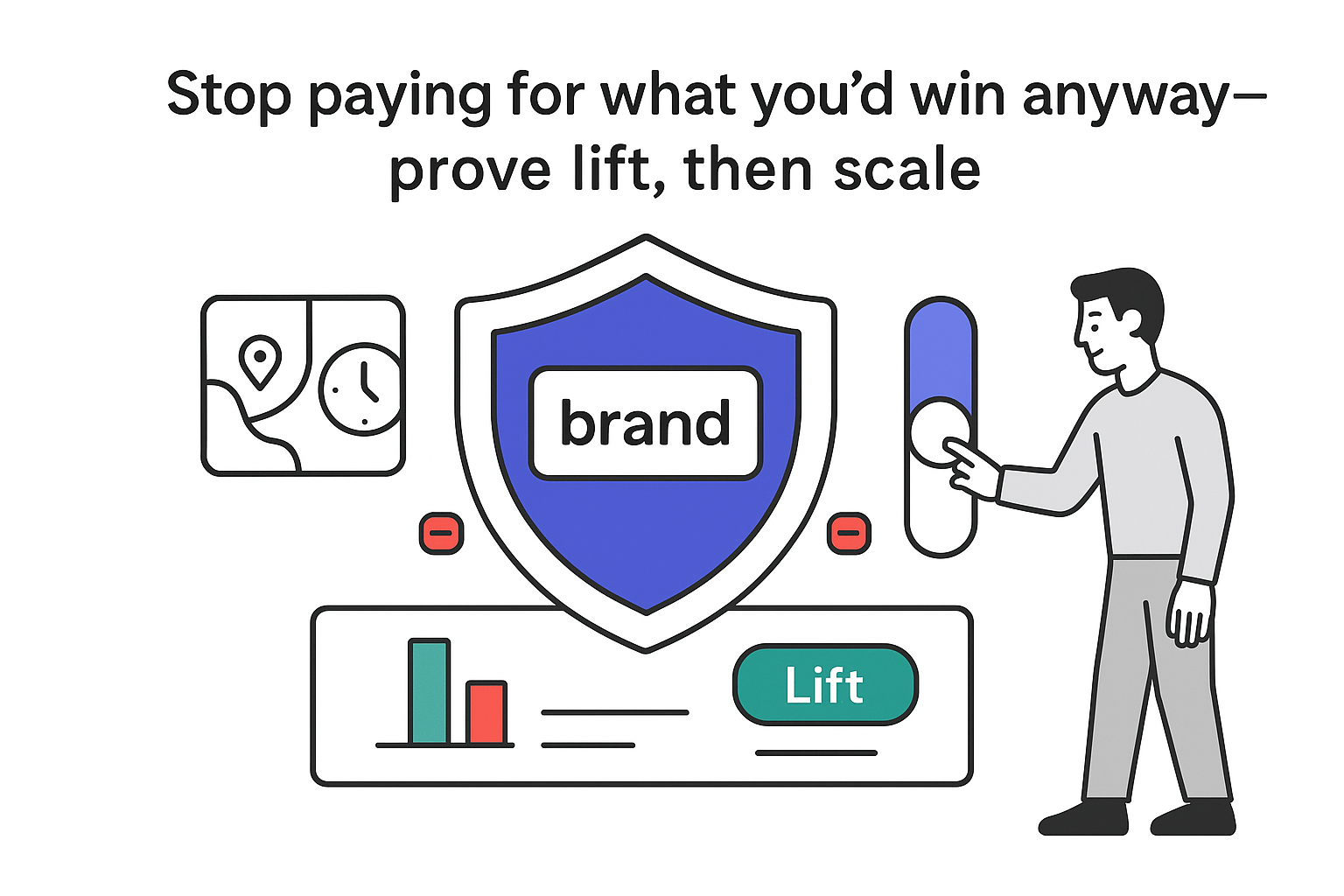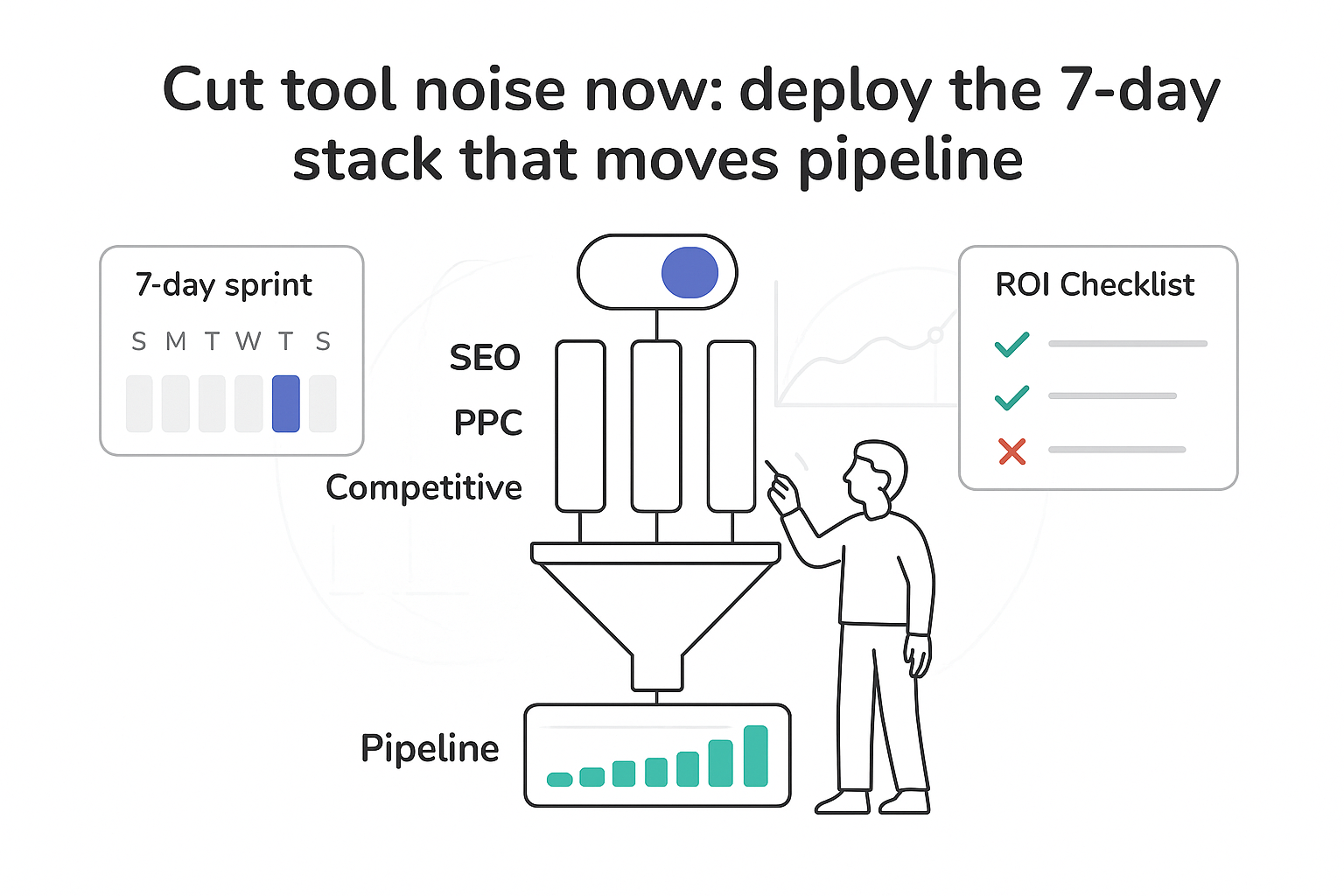You want a budget you can defend, not a finger in the air. If you run a B2B service company, you probably care less about clicks and more about meetings that turn into revenue. Good. I frame spend in those terms, keep the math simple, and set expectations you can live with while your pipeline builds.
How much should I spend on Google Ads: a budget that actually scales
Here is the direct, CFO-friendly answer: start with a monthly figure tied to qualified opportunities, not just leads. Use one quick rule, then pressure-test it with expected volume and time to signal.
- Fast rule: target monthly budget in dollars = target SQLs x target CPA. In typical B2B service auctions (US/EU), if CPC sits under $8, this often lands between $3,000 and $8,000 per month. If CPC ranges from $8 to $25, expect $6,000 to $20,000. If CPC is above $25, the floor rises fast and I plan for $15,000+ to get enough data and stability.
- Volume safety check: aim for at least ten clicks per day per test campaign so the system learns. If your CPC is $10, that implies about $100/day per campaign. You can estimate CPCs ahead of time with the Google Ads Keyword Planner.
I keep a simple mental calculator to align budget with sales goals:
- Monthly budget = target SQLs x target CPA
- Target SQLs = target deals ÷ win rate ÷ show-up rate
- Cross-check: ≥10 clicks/day per campaign
- Patience window: 6-12 weeks for a stable read
For context, see current Google Ads industry benchmarks to sanity-check CPC and conversion-rate assumptions by sector.
Pressure-test with volume, timeline, and scenarios
Two quick scenarios make the math concrete:
- High-ticket consulting with a long sales cycle. CPC around $18. You want 12 SQLs a month and can tolerate a $350 target CPA. Monthly budget pencils to about $4,200. With this CPC, that delivers ~233 clicks - enough to model early intent and feed remarketing. Expect real signal only after two or three full cycles of outreach and follow-up.
- Regional IT services. CPC around $7. Target CPA near $200. Aim for 20 SQLs. That suggests roughly $4,000 per month. Wins often arrive earlier because local intent is strong and brand queries can be harvested faster.
Plan for a learning period. Most B2B accounts need six to twelve weeks to settle. That is not procrastination - it reflects sales cycles, attribution lag, and the time it takes to call, book, and move opportunities forward.
The starting budget formula (CPC, CVR, and CPA)
Keep the math tight so you can adjust fast.
- CPA = CPC ÷ CVR (CVR is your conversion rate expressed as a decimal)
- Starting budget = CPA x target conversions (prioritize SQLs or booked calls over raw leads)
Alternative framing: budget as a percent of pipeline. Many teams set total ad cost of sales (TACOS) at 8-12% of target pipeline created. If you need $200,000 in sourced pipeline this quarter, a monthly media figure of roughly $5,300-$8,000 can be reasonable when sales coverage is strong.
Worked examples:
- Brand search. CPC ~$2, CVR ~18% to a simple call form. CPA is about $11. If you want 60 form submissions, media is near $660. These are not all SQLs, so apply a filter: if 1 in 4 becomes an SQL, your effective SQL CPA is ~$44. Keep brand separate to measure real lift.
- Nonbrand service terms. CPC ~$12, CVR ~6% to a focused landing page. CPA is about $200 per lead. If lead-to-SQL is 50% and you need 10 SQLs, plan on 20 leads: ~$4,000. If lead-to-SQL is 30%, you will need ~33 leads: ~$6,600. Fix the page or the offer before scaling if those numbers strain margin.
- Competitor terms. CPC ~$28, CVR ~2-3%. CPA ~$933-$1,400. Only run if lifetime value supports it and your messaging is sharp.
Small gains compound. If CPC holds steady and CVR climbs from 5% to 7%, CPA drops by nearly 30%. That is why tight landing pages and clean follow-up matter more than flashy ad copy in B2B. For more CPC context, see How Much Do Google Ads Cost?
Fit check: will Google Ads work given my conversion reality?
A quick fit check helps avoid sunk cost. Score each item 1-5; a total under 20 suggests a wait-and-fix plan is smarter.
- High-intent search terms exist for your service and locations. Confirm volume and commercial intent.
- CPC fits your gross margin. If one new client covers at least two months of expected spend, you are in range.
- Sales capacity is ready. If you cannot call leads within an hour during business days, CVR will sag.
- Geo and service area are clear. Vague coverage wastes spend.
- Page speed under two seconds on mobile. Slow pages kill conversions.
- Conversion tracking is clean. The primary conversion is an actual lead or booked call. Micro signals (scroll, time on page) are secondary, not the main goal.
If the score is strong, start with brand and high-intent search. If volume is thin or education is needed, layer in Demand Gen later to build lists - but keep spend light until search is stable. If you plan to test it, this overview of Demand Gen campaigns will help you set expectations.
Estimating and managing CPC
Estimating CPC well protects your margin. I triangulate using:
- Google Ads Keyword Planner: pull ranges by location; export top and low bids for top of page to set first assumptions.
- Auction Insights (once live): watch overlap rate and position. If a few heavy spenders dominate, you will see higher prices and must choose tighter themes.
- Historical account or CRM notes: any past campaigns, even from another channel, can hint at money terms.
Segment by intent so you do not average yourself into bad choices:
- Brand vs. nonbrand vs. competitor queries
- Local service phrases (near me, city/service area names) vs. national terms
- Problem-aware (e.g., "IT support outage") vs. solution-aware ("managed IT services")
Control price with query management. Use exact and phrase match for core themes and build a negative list from day one. See when to put your keywords in Exact Match. Keep broad match for later, when you have data and clear guardrails with audience signals and strong creative - including seeded audiences like Customer Match lists.
Raising conversion rates where they count
B2B lead gen has a wide band, and the page does most of the heavy lifting. Benchmarks on search:
- Focused landing page forms: often 5-12%
- Booking pages for discovery calls: 8-20% if friction is low
- Embedded lead forms in ads: can over-report quality; treat as a test, not your final source of truth
Practical lifts I rely on:
- Rule of 2: put two clear calls to action above the fold (e.g., "Book a consult" and "Get pricing") so visitors can choose without hunting.
- Trim fields: collect what you need to qualify now, not everything your CRM would like to store forever.
- Clarify the offer: spell out what happens after someone submits. Certainty increases action.
- Speed: compress images, kill heavy scripts, and aim for snappy load times.
Feed the system more signal early. Track micro-conversions such as click-to-call, calendar opens, and multi-step form progress. Do not optimize to them as your primary goal, but use them to spot friction fast. Keep website remarketing on to recapture high-intent visitors.
Turning monthly figures into daily plans and bidding
Once you set a monthly figure, convert it cleanly. Divide by 30.4 to get a daily number. A $6,000 month becomes about $197/day. Note: Google explains daily spend can fluctuate, but monthly charges are capped by your average daily budget times the number of days in the month.
Plan spend by campaign type so each has enough fuel to learn without starving the rest:
- Brand search: small but steady (often 5-15% of spend)
- High-intent nonbrand: your core engine (often 60-80%)
- Retargeting: keep it on for reminder value (often 10-20% depending on traffic)
Use Search Impression Share to diagnose underdelivery. If you sit under 10%, you are either underfunded for that theme or your Ad Rank is low. Raise bids, improve ads, tighten keywords, or shift budget across campaigns. For definitions from Google, see impression share.
Hit at least ten clicks per day in any new test so you can judge fit within a couple of weeks. If that is not feasible for a theme, pool topics or pause that slice until later.
Match bid strategy to data volume. Early on, Maximize Conversions is a safe starting point because it hunts for signal. Move to Target CPA or Target ROAS once you have a few dozen tracked conversions in the last month and stable lead quality. For tiny niches with limited queries, Maximize Clicks with a cap can help ensure coverage while you collect enough outcomes to switch, or use Target Impression Share to protect visibility.
Unit economics: LTV:CAC, payback, and fees
Guardrails that keep the math honest:
- LTV:CAC should land at least 3:1 for most B2B service models; higher if margins are thin.
- Payback under nine months is a healthy line in the sand for most teams; up to twelve months can still work on high-ticket retainers.
Longer sales cycles need better attribution. Use offline conversion imports so actual SQLs and closed deals flow back into the platform. Set longer conversion windows so late-stage actions count. Bid strategies do better once they see which clicks became revenue, not just form fills.
Media is only part of your cost to win a customer. Include the full picture:
- Common fee models: flat monthly, percent of ad spend, or a hybrid (base fee plus smaller percent of spend).
- All-in CAC = (ad spend + management fees + landing tools + third-party data) ÷ number of conversions. Example: if you spend $8,000 on media, $2,000 on fees, and $400 on tools and log 30 qualified leads, CAC is ~$347 before sales handling. If 40% become SQLs (12), SQL CAC is ~$867. Now compare to LTV and margin.
Set expectations up front:
- Reporting tied to pipeline created, not just clicks
- Ownership of accounts, audiences, and creative so you are never locked out
- Service rhythm aligned to sales cadence (e.g., weekly pipeline syncs)
Frequently asked questions
What is a realistic starting budget for B2B services?
If CPC is under $8, many teams start between $3,000 and $8,000 a month across one to two search campaigns. With CPC between $8 and $25, plan for $6,000 to $20,000 to get enough volume to judge fit.
How long until I see results from Google Ads?
Expect a learning window of six to twelve weeks. That covers modeling, sales follow-up, and at least one full cycle of outreach. Early signals arrive sooner, but reliable trends need time.
Should I run brand and nonbrand together?
Keep them in separate campaigns. Brand protects your name and tends to convert well. Nonbrand proves you can win net-new demand. Separate budgets and reporting make decisions cleaner.
How do I handle low conversion volume in early stages?
Track micro steps, expand match types cautiously, and group tightly related themes so each campaign reaches ~10 clicks/day. Use calendar bookings and calls as primary conversions, not page views. For more tactics, see Google Ads on a small budget.
Is Demand Gen worth testing for B2B?
Yes - but only after search is stable and funded. Start small to build audiences and learn creative angles. Treat it as a complement, not a replacement, for high-intent search. Learn more about Demand Gen campaigns.
How do I factor LTV and payback period into budget?
Work backward. Set a target payback (e.g., 6-9 months), then cap CPA accordingly. If LTV is $15,000 and margin is 50%, you might cap CAC at ~$2,000. If modeled CPA is higher, fix conversion or adjust targets before scaling.
What if CPCs are too high in my niche?
Tighten themes, use exact and phrase match, build a strong negative list, and shift to more specific queries that signal purchase intent. Improve Ad Rank with relevant ads and landing pages. If prices still crush margin, protect brand and referral/partner keywords while you develop other channels.
What if my market is tiny?
Lean into coverage. Use higher Impression Share targets on core terms, expand geography where it makes sense, and accept that volume will be modest. Pair search with retargeting to catch the small pool of buyers when they are ready. Consider Target Impression Share or a capped Maximize Clicks during early data collection.
How should I think about sales capacity?
If your team cannot follow up within an hour, conversions will slump and CPA rises. Budget for what you can handle. It is better to add spend when capacity opens than stack leads you cannot work.
Do I need offline conversion imports?
If your cycle runs longer than a week or you qualify by phone, yes. Send SQLs and closed revenue back into the platform so bidding learns from true outcomes, not just raw leads.
I favor a steady plan over a flashy start. Tie spend to SQL goals, watch the math, keep pages fast, and give the program enough time to learn. When the numbers hold and the phone keeps ringing, scaling feels simple because it is backed by a clear model rather than guesswork.







.svg)